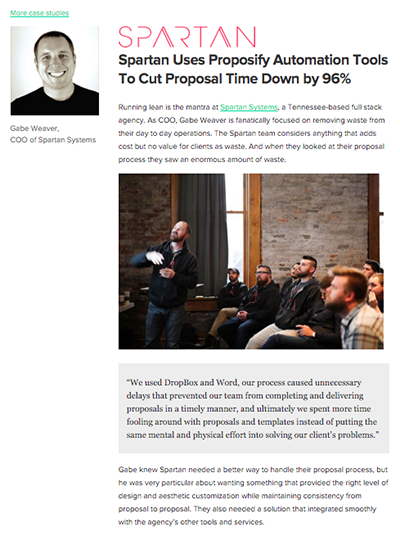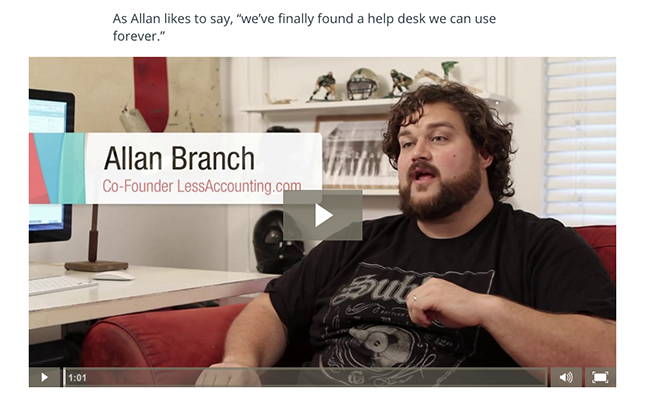Case Studies: Win More Proposals With These 9 Tips and Examples
October 10, 2017Last updated on October 1, 2024

9 Tips to Win More Proposals with Case Studies
If you’re not including case studies in your proposals, you’re missing out on a huge opportunity. When it comes to winning new work, sales case studies are more than the icing on the cake, they’re the proof that’s in the pudding.
During the preparation of the countless number of proposals I worked on during my years in the agency trenches (and sadly we had no Proposify back in those dark ages), inevitably someone would raise the question, “Do you think we should include case studies?”.
As if it were a choice.
My strong belief is that you should ALWAYS include sales case studies with your proposals, especially when going after new leads who don’t know your experience, ability, or successes.
The exception to this rule might be when you’re doing up a quick proposal as a formality for a new project with an existing client. But be careful. It can be easy to assume existing clients already know everything you do and have done, but often they only know you in the context of the work you’ve done for them already.
Proposals outline what you’re going to do for a client. Case studies prove that you can do it.
Proposals outline what you’re going to do for a client. Case studies prove that you can actually do it.
No matter how many times you claim to have “extensive experience”, without a case study to back it up, those words can be meaningless, and risky, to a new prospect.
Businesses are often resistant to including proposal case studies because it’s more work to create them on top of everything else, especially when you’re in the time-sensitive throes of preparing a proposal.
The key is to stop seeing case studies as optional and instead view them as an essential selling tool; the tool that just might be the tipping point between you and competition.
Here at Proposify, we've seen a really good return from featuring case studies on our site:

Proposal case studies don’t have to be complicated; they just have to be convincing.
Here’s a simple guide to creating compelling case studies that close deals. You can expand on these to make your particular case studies more elaborate if you like, but as long as you have the basics, it should do the trick.
1. Develop sales case studies before you need them
I admit I have groaned at the thought of doing up case studies when we’re T-minus zero trying to get a proposal out the door. But the trick is to have them ready to go BEFORE you need them in a crisis.
Assign case study writing to your team as a proper internal project and start developing them between proposals.
It will be a lot easier if you’re regularly doing debriefs with clients after each project to see how things went and then following up a few months down the road to track results. This way you’ll already have source material to work with plus compelling stats that make your case studies stand out.
You can customize them to fit the particular need of each proposal once the time comes, but at least you won’t be running around trying to decide which projects to do, getting permission from clients, writing the copy, getting approval, hunting down images, and designing them all at the last minute.

2. Make them representative and recent
When deciding on which projects to turn into case studies, make sure they represent the range of your services. That way you have case studies ready to go that reflect all the types of projects you might be bidding on in a proposal.
Ideally, you have a couple of case studies for each service and main industry but if you can focus on having at least one good, results-driven case study for each area of your business offering then you’re covered.
Also, make sure each case study is fairly recent. Technology, markets, and industries change quickly, so you want to be sure you’re demonstrating that you’re relevant, leading edge, and in demand.
Depending on the industry and service two years, three tops is a good life cycle for a case study.
3. Get client permission
Once you have your list of projects you want to feature as case studies, the first thing you should do before actually going to work on them is to get permission from the client to feature their company.
Some clients don’t want their business challenges or practices talked about publicly for a variety of reasons. Issues related to liability, privacy, and competition can make clients a little shy of the spotlight.
Government clients can be hesitant about case studies, but sometimes they’ll work with you to omit sensitive details so you still get a solid case study that makes everyone happy.
For other clients, case studies can be a great way to promote their business. You can let them know the case studies will be featured on your website and blog in addition to being included in proposals.
Since you’re only going to feature projects that had a positive outcome, clients will be happy to be seen as “successes”. It makes them look smart for choosing the right solution, and they get to show off their good results.
4. Get a client testimonial
You can say all you want about how great your work was for Client X but a direct quote from Client X, about how awesome it was to work with your company or how their business improved as a result of your solution is GOLD.
Ask your client for a quote on the project you’re highlighting and make it as simple as possible for them respond. It’s helpful if you give them some direction, but you want to be careful that they don’t feel you’re putting words in their mouth. Sometimes a client will prefer to have you to write it for them, and then they tweak and approve it. You can offer that as an option to make it easier for them.
If you can, get a couple of quotes related to different aspects of the project that way you can mix and match depending on what you need for the proposal. You can make this easier by giving the client some framework for their testimonials by asking them questions like:
- What was it like working with the team at our agency? Did you find the process simple? Did you find people knowledgeable? Easy to work with? Flexible?
- What kind of benefits have you seen in your business since we did X project for your company?
- Would you work with us again? Why?
Here at Proposify, we book calls with our customers to get their feedback and we use this information as the basis for our proposal case studies.
We like the direct contact with our customers and it’s sometimes an easier way to get information from them compared to waiting for a response to an email when they’re super busy. Plus it allows us to get quotes that sound like they’re from real humans as we use their owns words.
We usually asks these five questions:
- What made you try Proposify?
- What was your ‘a-ha!’ moment to sign up for a paid account?
- Has Proposify improved your sales?
- Does using Proposify influence your close rate?
- Was there a situation where Proposify saved the day? Or helped you out?
We record the call so the content team can listen to it later and transform the conversation into a case study that we'll feature on our website and promote through social media. Check out some of our business case study examples on our site.
Obviously, you’ve picked this client because you already know these types of questions are going to prompt positives answers. Depending on how complete the answers are you may need to edit the testimonials a bit and if you do, be sure to send them back to the client for their approval.
5. Tell a story
When it comes to writing a case study, lead your reader on the journey of the project and keep it focused on the client. Don’t just say, “We built a new website for Bob’s Burgers because the other one was really out of date and not responsive.”
Tell a story that includes the following elements:
Background: Briefly introduce the company, what they do, their industry. It gives some context for the reader.
The Challenge: Why did the client come to you? What problem were they looking to solve? What issues were they facing in their industry that made them reach out? Why did they choose your company to help them? Be careful that you don’t paint your client or their business in too negatively when describing their challenges.
The Approach: What did your team do to address the problem? What was the process you went through to come up with that solution? Why did you decide that solution was the right one?
The Result: Explain the results your solution delivered to the client, whether anecdotally or even better with hard numbers if you have them. How it made life better for them, how it helped them achieve their goals, solved their challenge, and how they are now positioned for a successful future. RESULTS ARE CRITICAL. If you can’t demonstrate positive results, don’t include the case study. Results are everything.
In fact, we put results front and centre by including them in our case study headlines.

I find breaking a case study down into these chunks makes it less daunting to prepare, giving you a clear framework to follow.
6. Keep the format simple
There are lots of different formats for case studies. I like my case studies to be concise (one page TOPS, including images), easy to skim, and easy to determine the result of the project.
You don’t have to literally use the subheads of background, challenge, approach and results but like blog post subheads, it makes the whole thing easier to read and they get right to the point.
Just like your proposal, the client is likely skimming everything but the pricing page so make it easy for them to get the important juicy bits you want to drive home.
7. Use beautiful images or video
Include images of your work in your case study and for the love of PNG, make sure they are high res and LOOK GOOD.
If the project is non-visual like strategy, design a sharp-looking infographic that demonstrates some aspect of the project, like the results or something related to the client’s business.
Where appropriate show before and after shots but again tread carefully in this area. While it can illustrate how far the company has come and the awesome work you did for them, you want to be sure the company is not made to look bad.
To make your testimonial even more powerful, include a video clip in your proposal of the client talking about the project. Online proposal software like, oh, I don’t know...Proposify?...lets you seamlessly add videos to your proposal. But just like images, make sure the video quality is good, the sound is clear, and the whole thing is professionally shot and edited.

8. Customize case studies to your proposal
The question often falls to “how many case studies should we include?”. I think three is plenty and you can always direct the reader to the portfolio/work/customers section of your website for more (you do have a portfolio section on your site, right?).
The case studies you include should correspond to the needs of your prospect for the particular proposal. Maybe it’s a client who had a similar challenge or who experienced benefits from a similar solution that you’re proposing.
Take the time to review each case study before including it in a proposal to find ways to tailor it to help demonstrate to your sales lead that you have experience solving their particular challenge and you know how to deliver.
For example, if your prospect is looking for a new website that’s responsive with an e-commerce solution and requires copywriting, don’t just send them a case study about how you built a kick-ass website. Make sure it demonstrates all those services.
9. Practice plain language
As with anything you write, be sure to follow the rules of plain language writing. Don’t use jargon, be concise, be straightforward, be positive, avoid the passive voice, and if you need to use technical terms or acronyms, include explanations. Don’t assume your client knows what CSS is.
Conclusion
Case studies are the best way to put the walk in the talk of your proposals. They can help build trust with a prospect with whom you don’t yet have a relationship.
They don’t have to be long, complicated, or with earth-shattering results for the biggest brands in the land. They just need to demonstrate that you can do what you say you do and when it comes right down to it, that’s all a client really wants to know.

Director of Communications @proposify. Channeling Maria Von Trapp, Queen Elizabeth II, and my taxi-driving, yard-sale-obsessed grandmother. Professional word nerd and unapologetic disciple of the Oxford comma. Connect on LinkedIn



